Month: May 2019

Survey: Half of IT Pros Believe New IT Talent Unprepared—Most Admit They Need New Training Too
New survey data published by INAP found that half of IT pros (49 percent) don’t believe “that the new talent entering the IT workforce is adequately prepared for the roles and responsibilities of today’s IT environment.”
It’s not just new talent that they believe needs more training, however.
Current IT pros also don’t feel adequately equipped for the increasingly complex world of modern IT; 71 percent agree they “could use more training on all of the different types of server and cloud infrastructure that we use and plan to use in the near future.”
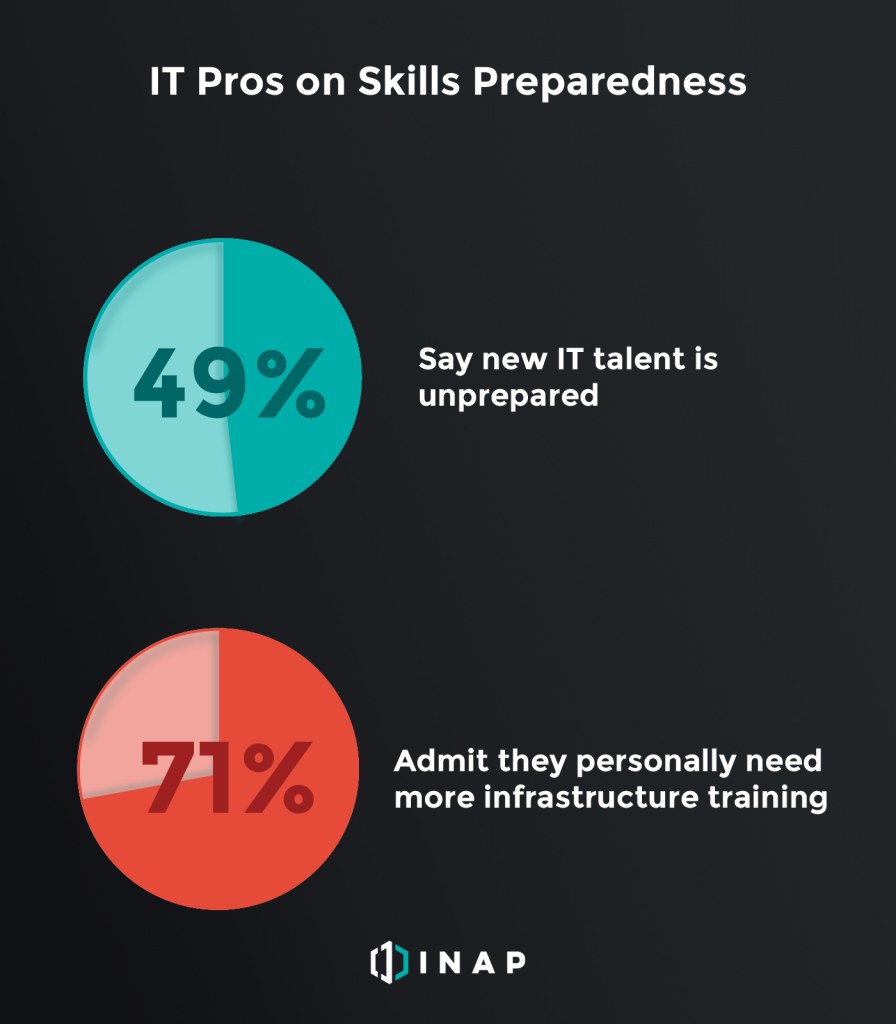
One explanation, according to Jeff Atkinson, CIO of INAP, is that modern enterprise IT is more complex than ever.
“IT’s traditional function of equipping their organizations with the technology systems and tools they need to thrive has been augmented with a strategic role in driving digital transformation,” said Atkinson. “Given the fast, ever evolving pace of technology and its uses within the enterprise, it’s an enormous job for IT teams to just keep up with best practices for operating, maintaining and securing their software and systems—let alone drive innovation as a true partner to business units.”
The survey data indicates that despite a growing list of roles and responsibilities, IT professionals are eager to evolve on the job and stay ahead of the learning curve.
IT Pros Wear Many Different Hats
INAP prompted the 500 survey respondents to reflect on their roles in IT, asking them, “Throughout your time in IT, do you feel that you’ve had one singular focus, or do you think you’ve held many different ‘occupations’?”
Tellingly, 95 percent said that they’ve had more than one singular focus. Four in 10 said they’ve had more than five roles (including 13 percent who said that they’ve worn a different hat every single day they’ve worked in IT), and over half (53 percent) identified two to five roles.
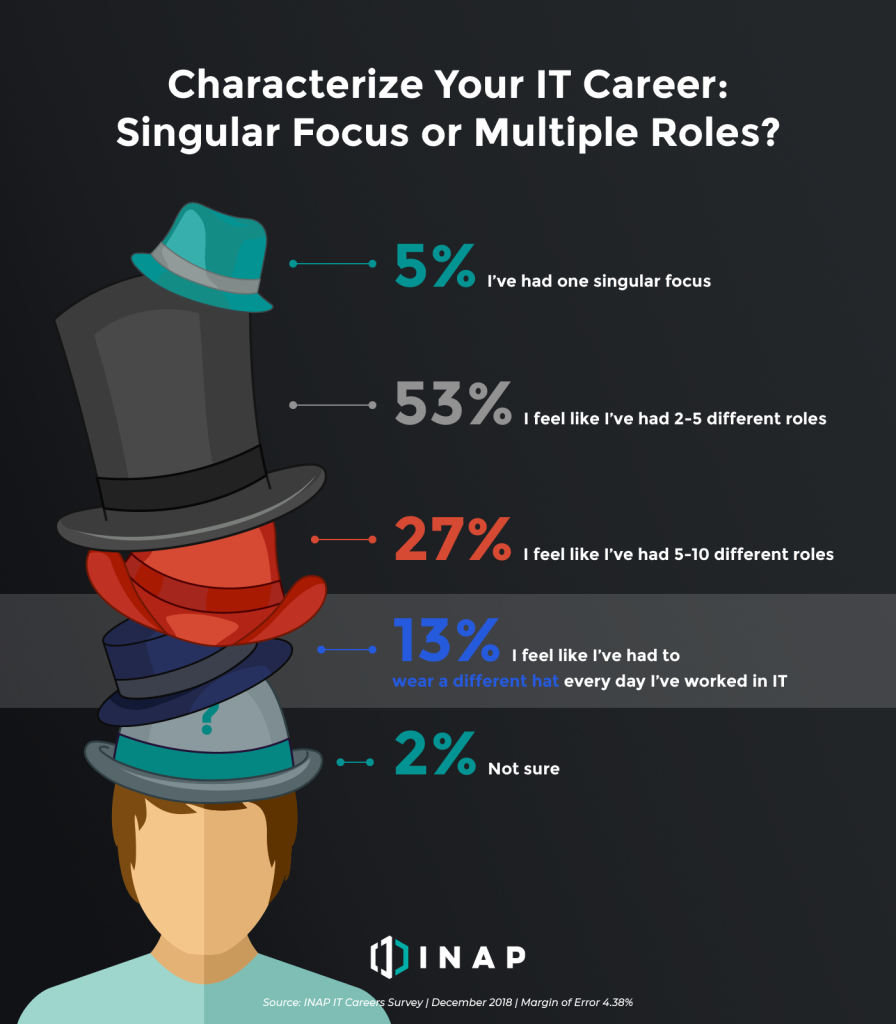
With the rapid pace at which new technology, platforms and certifications emerge—not to mention the shift to multicloud and hybrid IT, which demands a wide range of expertise—it’s perhaps no wonder that many IT pros have continually experienced major shifts in their roles and responsibilities over time. (Case in point: AWS alone released 497 new features in Q4 2017.)
IT Pros Are Dedicated to Continued Learning and Training
Given the fast clip at which new technology is emerging, what are IT pros doing to keep up even with time and resource constraints? The answer: a lot.
We asked IT pros how often they’re learning new skills, taking classes or otherwise refreshing their IT skill set. Nearly four in 10 are doing so on a monthly basis (37 percent) and one out of 10 on a weekly basis (11 percent). Three out of four are engaged in continued learning or training on at least an annual basis.
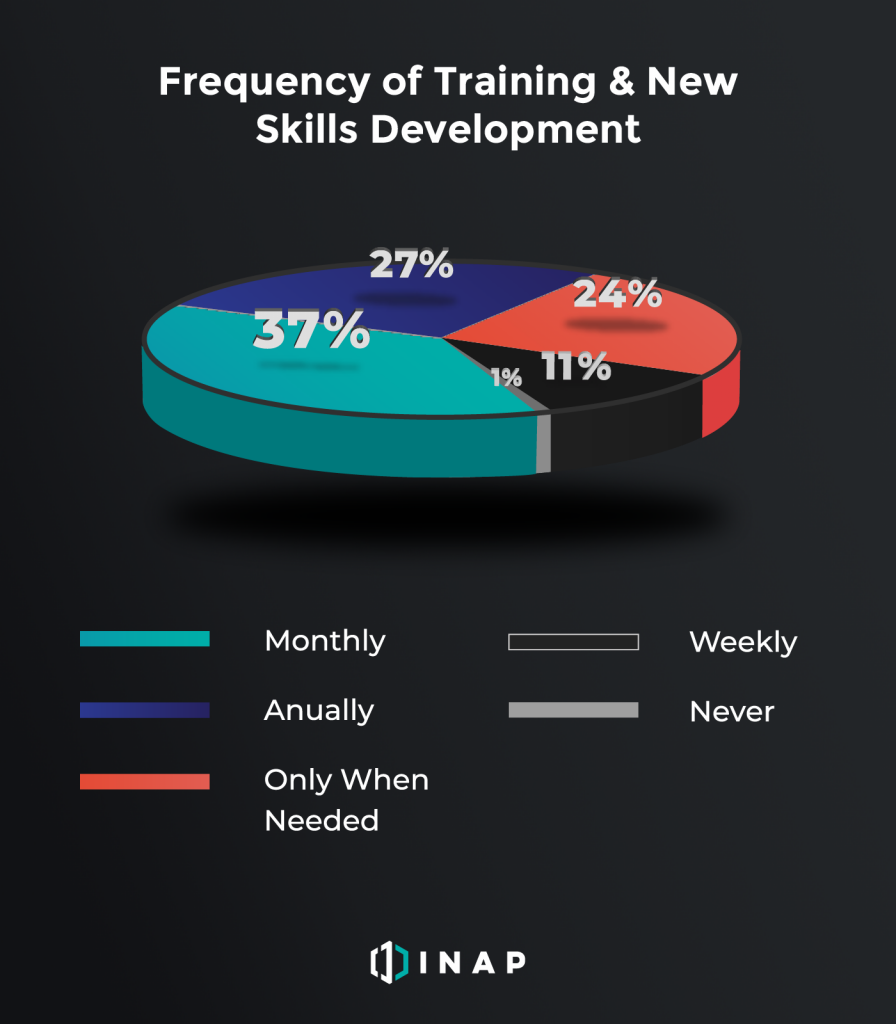
It’s clear that IT pros are extremely dedicated to keeping up with new skills and technology, certainly driven in part by necessity. It’s not surprising then that less than half of respondents (45 percent) believe that their organization is taking full advantage of their experience and skill set.
The reason for the disconnect may lie in the fact that even as IT organizations are leading the charge in enterprise digital transformation, much of individual IT professionals’ time is still taken up by routine maintenance.
The Future of IT Depends on Continued Innovation
The skillsets that have come to define traditional enterprise IT are not likely to be the same skills that unlock the next level of the business function’ s evolution, according to Atkinson.
“Soft skills like emotional intelligence, innovativeness, business acumen and flexibility have become just as important as technical know-how,” he said. “They will only grow increasingly necessary for modern IT professionals as their departments become more aligned with the goals of the business.”
The IT pros we surveyed agree: 51 percent identified innovation and flexibility as the most important skills for new talent to have.
As IT shifts from an operational function to a strategic partner in digital transformation, the talent profile of the average IT worker is also likely to change.
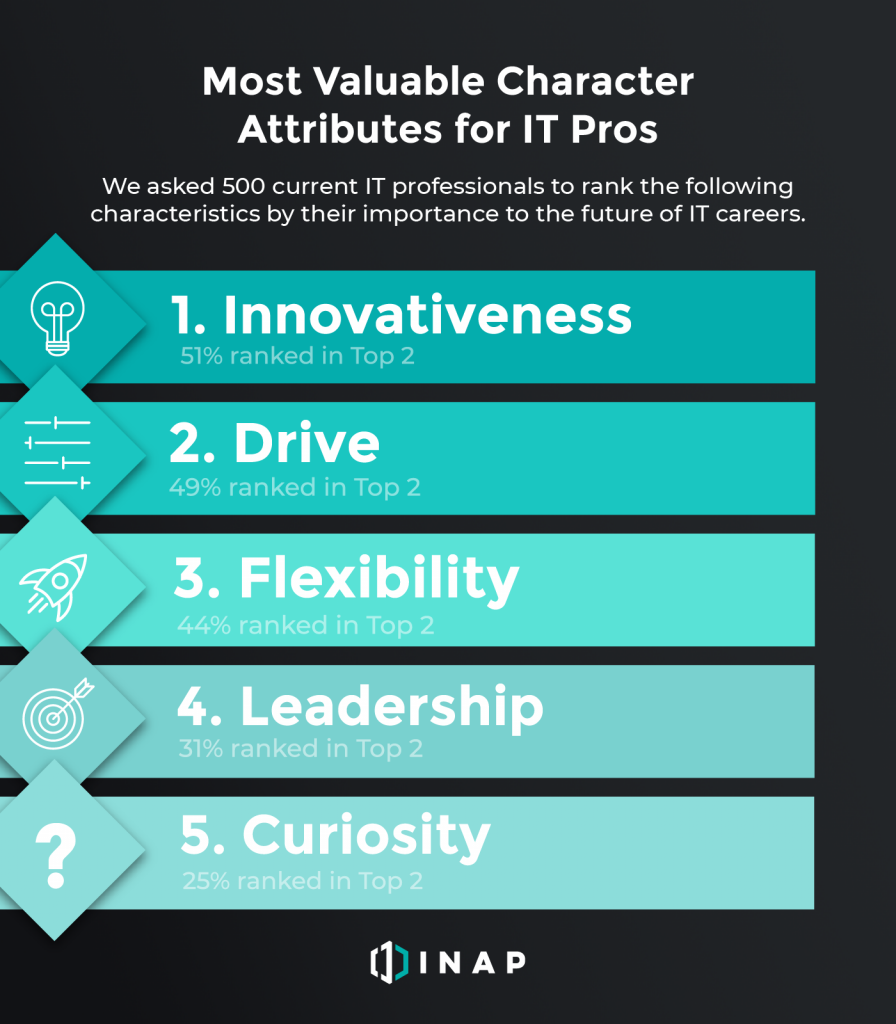
To realize IT’s potential as a true center of innovation, IT pros are looking to develop and hone skills that aren’t just technical. In this way, the transformation of the IT organization must be driven by the transformation of the average IT worker.
The question then becomes: How can enterprises create the space needed for the growth and evolution of their professionals?
About the Survey
The data used in this article was derived from a survey of 500 IT professionals with data center, server, and cloud infrastructure responsibilities who work at businesses and enterprises in the United States and Canada. The survey, commissioned by INAP and facilitated by Precision Sample, was conducted in Q4 2018 with a margin of error of 4.38%.
Explore HorizonIQ
Bare Metal
LEARN MORE
Stay Connected

INAP Introduces New Managed AWS Support Plans
INAP announced today its new Managed AWS support plans, offering greater service capabilities and more flexibility for a broad range of public cloud use cases and budgets. Each plan offers critical features and benefits like consolidated billing, access to certified AWS architects and technicians, and around-the-clock troubleshooting.
Premium features include advanced deployment services, interconnectivity to AWS from INAP data centers, flexible solution architecture, and comprehensive reporting and cost optimization consultation.
You can learn all the key details of the support plans—Service First On-Demand and Service First Premier—by reading on below or heading to our Managed AWS service page.
First, though, some context for why we believe Managed AWS with INAP is a whole lot more than a one-off solution.
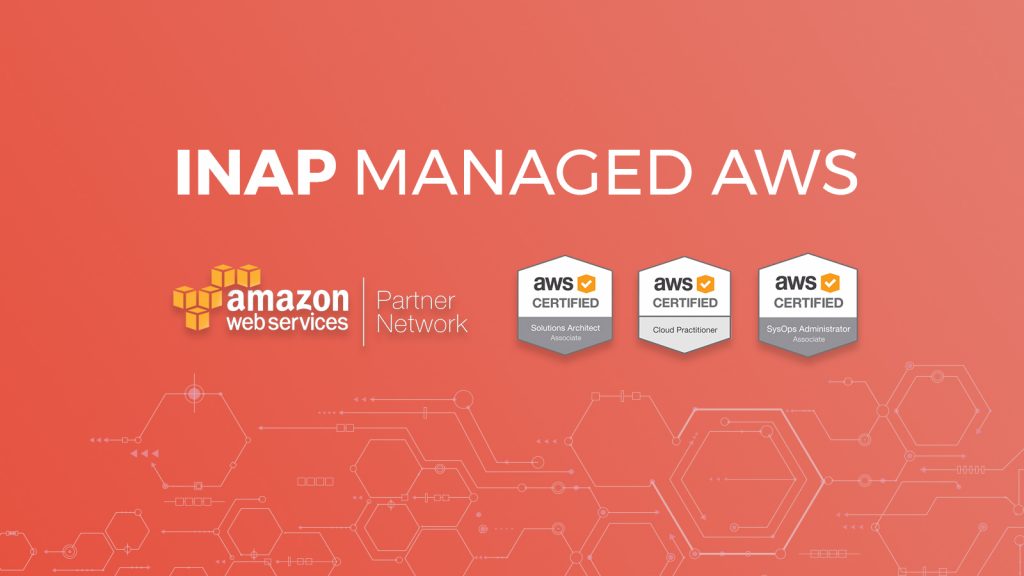
Multicloud & Hybrid IT Have Arrived
Managed AWS complements INAP’s existing cloud, colocation and network portfolio, allowing customers to fully realize the potential of hybrid strategies shaping the future of IT.
As reported in INAP’s 2019 State of IT Infrastructure Management, on-premise-only IT strategies are facing steep decline. A majority (56 percent) of organizations currently maintaining their own data centers will be moving at least some of their infrastructure off-premise within the next three years; 78 percent of those organizations will be selecting hyperscale providers like AWS for specific workloads.
The challenge for many organizations, however, is that AWS is whole new ball game from an operational and economics perspective.
While the platform offers compelling solutions for a variety of applications, it is as complex as it is powerful. Even for skilled IT infrastructure professionals, achieving proficiency in the platform and its ever-growing list of tools and products is no easy feat. According to Amazon’s own recommendations, attempting the AWS Solutions Architect Associate certification requires a year of platform experience and studying. Practitioners chasing mastery can add another year for the Professional certificate and several months of prep for specialty certifications like networking and security.
Do you need these credentials to spin up a cloud environment on AWS? No, but we believe there are two related reasons Amazon emphasizes their certification programs and maintains a vast database of technical documentation.
First, AWS’s support model is designed for DIY shops. Outside of resolving underlying AWS infrastructure and network issues, Amazon leaves you on your own for environment configuration and optimization.
Second, running mission-critical workloads in AWS without a deep understanding of the platform’s nuances and complexity can lead to significant problems: sticker shock and blown budgets, workload performance degradation, or worse yet, security vulnerabilities and downtime caused by environment misconfigurations and architectural mistakes.
For many IT organizations operating hybrid and multicloud strategies, learning a brand-new platform is not the best use of time and limited resources.
In fact, nearly 8 in 10 IT pros we surveyed believe they could bring more value to their organization if they spent less time on routine tasks like cloud server monitoring and maintenance. Increasingly, IT professionals’ skills are better spent on value-added tasks like new application development and collaborating with business units on new technology initiatives.
This is all to say that Amazon has made a conscious choice to rely on third-party partners like INAP to help customers succeed.
Our Managed AWS plans are carefully designed to help IT organizations achieve the promise of hyperscale cloud without confronting operational headaches along the way.
Simply put: Our experienced team of AWS certified solutions architects and support experts mastered AWS so you don’t have to.
INAP Managed AWS: Service Plan Overview
Managed Support Services
Service First On-Demand
For a low monthly fee, customers receive core infrastructure monitoring and response, ticketing and hotline access, consolidated billing and basic issue mitigation—e.g., break/fix and simple configurations.
Service First Premier
A fully managed, proactive support experience with advanced monitoring, performance optimization best practices, and detailed monthly reporting. You’ll receive hands-on management for all supported AWS services active in your deployment. For infrastructure issues with AWS data centers, our team will work directly with Amazon representatives.
AWS Migration Support and Deployment Services
For customers new to AWS or for customers deploying new environments, INAP offers two tiers of onboarding and deployment services.
Tier 1: A certified onboarding engineer will implement architecture best-practices tailored to your applications, spin-up your instances and configure services.
Tier 2: This white-glove onboarding service includes everything from Tier 1, plus:
- Custom image configuration
- Network and load balancer configuration
- Access management and security configuration
- Set up of up to five enhanced AWS services
Add-on services include advanced solution architecture for complex deployments, migration support and AWS Direct Connect configuration.
Deployment services are only available to customers signing up for one of INAP’s Service First support plans.
Common AWS Use Cases
INAP’s AWS experts support a vast array of Amazon’s powerful toolkit, specializing in four primary areas: hyperscale compute and storage environments, off-premise backup, serverless, and multicloud.
Hyperscale: INAP manages and optimizes your core AWS infrastructure, including EC2, VPC, ELB, S3 and RDS.
Off-Premise Backup: Using AWS’s wide range of cloud backup storage services to support both application and archival compliance requirements, INAP manages the backup schedule and data life cycle.
Serverless: Using AWS Lamda, INAP will design and operate the ideal environment for your serverless backend and data processing systems.
Multicloud & Hybrid: Pair the ideal AWS solution with your on-premise, INAP Colo or INAP Cloud environment to improve performance and reliability.
In the coming weeks, we’ll break down common reference architectures for each of these specialty areas and share advice for getting started.
In the meantime, chat with us today and download the following resources:
INAP Managed AWS Overview [pdf]
INAP Managed AWS FAQ [pdf]
Explore HorizonIQ
Bare Metal
LEARN MORE
Stay Connected

INAP Executive Spotlight: Jennifer Curry, SVP, Global Cloud Services
Welcome to the first installment of the INAP Executive Spotlight. In this series, we’ll be interviewing senior leaders in the company, hearing candid reflections about their careers, the mentors who shaped them and big lessons learned along the way.
 First up is Jennifer Curry, SVP of Global Cloud Services. An industry thought leader and champion of unsung IT workers everywhere, Curry is responsible for the architecture, infrastructure engineering and technical support of INAP’s cloud and hosting solutions, including bare metal, private cloud, managed hosting, third-party managed cloud and business continuity.
First up is Jennifer Curry, SVP of Global Cloud Services. An industry thought leader and champion of unsung IT workers everywhere, Curry is responsible for the architecture, infrastructure engineering and technical support of INAP’s cloud and hosting solutions, including bare metal, private cloud, managed hosting, third-party managed cloud and business continuity.
Read on to hear her take on what makes a great leader, the challenges of diversity in the industry and how our office’s most vocal Fighting Irish fan almost became an accountant.
The interview has been lightly edited for clarity and length.
Tell us how you got into IT/tech. What inspired you to pursue it?
It was a little by accident, to be honest.
I come from a family of accountants, and I assumed I would simply follow in their footsteps. I went to Notre Dame and graduated (from the best business school!) with a degree in accounting. A career in IT wasn’t on my radar.
Fast forward to my second job after college—I was working as part of the finance organization at Platinum Technology. They decided to start a financial systems group inside of the organization and asked if I would be interested in being a part of the group. Never one to back down from a challenge, I said “sure.”
I fell in love with the systems work immediately. From there, I continued in IT and eventually into engineering operations.
What’s a typical day like for you?
I don’t feel like I have a typical day, which is why I love what I do. It is actually true that there is never a dull moment in my world.
As a P&L owner, I spend considerable time looking at the financial health of the business unit—reviewing sales, updating forecasts and trends, evaluating spending. But the best part of my job is working with my teams on new products, reviewing technology updates and engaging with our customers to strategize on their needs and how we can help.
What do you love about your role in tech? What do you think is the best part about being in the tech industry?
Our industry is always changing. It is highly competitive, and you have to consistently ensure your value proposition aligns correctly with the market. Being a competitive person, I embrace that challenge. As a service provider, we are exposed to more emerging technology than a typical enterprise IT organization. It’s exciting to be close to the VC markets and the technology they are bringing to the industry.
How have you seen the industry change over your career in regard to diversity? How would you like to see it change?
There has definitely been a change in raising the awareness on inclusion in the tech world. However, I am still the only woman at the leadership table more times than not. Obviously, change like this takes time and it is important for those of us who are in leadership positions to not become complacent. We cannot stop being surprised or disappointed when we walk into the room and don’t see diversity in the folks sitting at the table. We have to remain vigilant in our execution of changing the look of the IT workforce.
Out of the qualities you possess, which do you think has had the greatest influence on your success?
This probably sounds cliché, but my competitiveness is likely what has propelled my personal career growth the most. I am talking about competitiveness with myself and constantly expecting that my execution is better every day. If I were to always focus on competing with the person next to me, I wouldn’t be as successful. It wouldn’t fuel the right growth focus.
In my role as a leader, I believe loyalty is the quality that helps develop and maintain high-performing teams. If your team trusts you, they will deliver more for you.
Who are the people that have mentored you or been role models?
Kristin Ruth was my first true mentor and the reason I stepped into this IT world. She plucked me from working in Excel spreadsheets 12 hours a day and put me into a financial systems role.
Doug Butler has been influential in my career for the past 10-plus years. He was the CFO at Looking Glass Networks and Latisys while I was at both companies. I seek his advice often. You wouldn’t think that a CFO would be an IT person’s mentor. But it makes sense since we spend a considerable amount of time managing our spend and ensuring we can articulate the ROI of what we are doing to our business leaders. He is now the CEO of an employee engagement software company and provides me a very different perspective on leadership these days.
What are your thoughts on work-life balance and have your ideas changed over time?
Burned out employees are not good employees. That’s why I encourage balance. You have to shut off sometimes in order to remain fresh and able to operate at your highest potential. Our culture is an always-on mindset, but if you look at the top technological minds, they all take time out (a lot through meditation).
What advice would you give to someone pursuing IT as a career path?
You are going to have to self-study—a lot. If leadership is your goal, realize that means putting your team first, over yourself.
How would you do things differently (if at all) if you were starting out now?
I’m not sure I would change anything. I wouldn’t be who I am if I took a different path.
What are some of the big lessons you’ve learned in your career?
Be open to new opportunities and just work hard. If you work hard and execute consistently, opportunities come your way. I didn’t seek out many of my positions: They were offered to me based on my track record of execution and my willingness to take on something new.
I’ve been terrified of some of the roles that were given to me to be honest. I think that is why I have been successful in such a male-dominated industry—I wasn’t afraid to be afraid.
Watching people interact, listening not just to learn about what they are saying but to seek to understand the dynamics of how people react to one another. Sometimes people mistake the quiet ones for being disengaged, but those are the folks who are going to blow you away because they have taken the time to truly understand all of the dynamics of a situation or event.
Read our next Executive Spotlight featuring INAP’s Senior Vice President of Human Resources, Jackie Coats.







